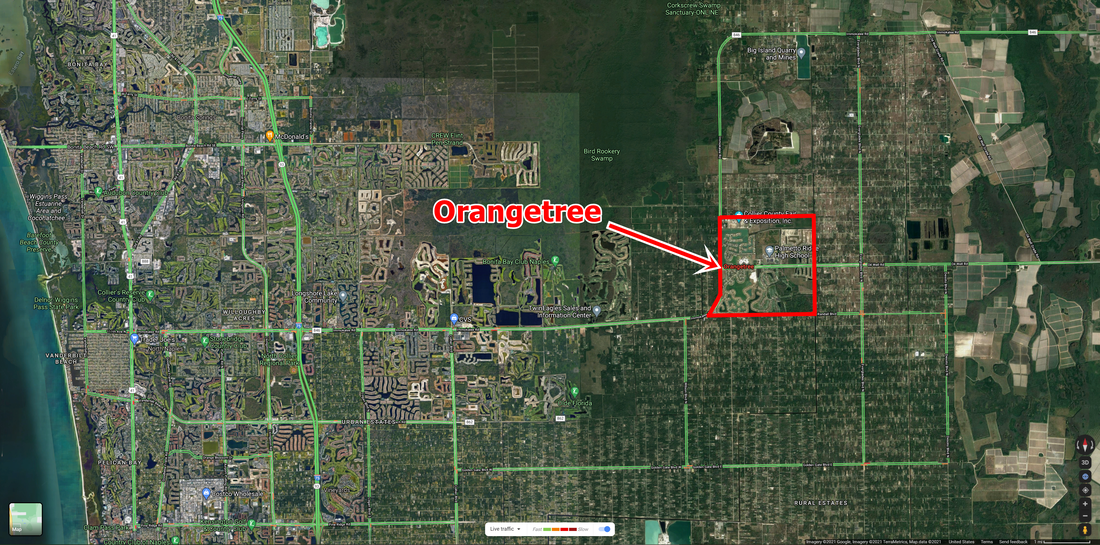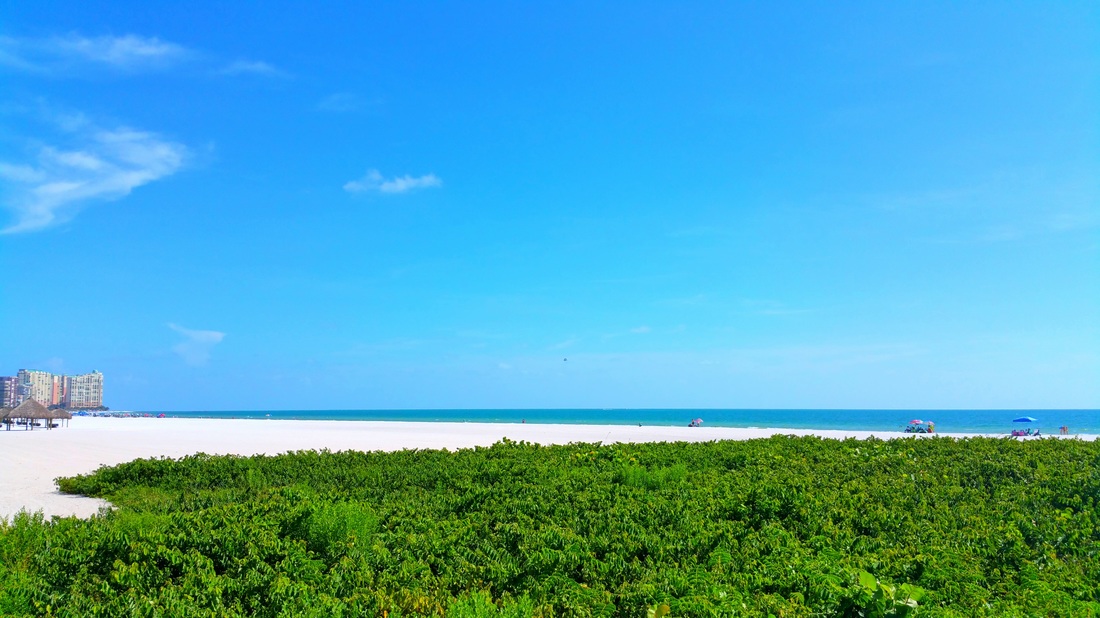|
By: Danny Berger Did you know that a small area in Collier County experiences more lightning than any other place in the United States according to the Bulletin of the American Meteorological Society? A 4.4 square mile census-designated place with a population of approximately 4,400 (2010 census) in northeast Collier County called Orangetree is the spot for all these flashes of lightning. Orangetree experiences around 200 lightning flashes per square mile a year. Globally though, Orangetree only ranks 122nd in the world, which is crazy to think that so many more places in the world experience more lightning on a yearly basis. To read more, check out the full study here.
Orangetree is located inside of the red square and is off of Immokalee Road in the central right part of this map.
0 Comments
By: Danny Berger As many of you may know, Lee and Collier county beaches can unfortunately be affected by red tide. Red tide in southwest Florida is a naturally occurring phenomenon that can last anywhere from a few days to well over a year, and thankfully the beaches have started to look pretty good again for the last month and a half. This past summer was particularly bad for red tide, which led to a little bit of hysteria and false information about red tide at our beaches. With that being said, I wanted to help set the record straight about red tide in southwest Florida and provide a bunch of reliable red tide resources all in one place for people to see. For starters, check out Collier County Pollution Control’s red tide facts and myths video/PowerPoint, it has a ton of really useful (and scientifically backed) information about red tide. Also, check out the compiled list below for more information regarding red tide in southwest Florida:
By: Danny Berger So it feels like forever since anything new has been posted on our blog (which it essentially has, 329 days to be exact), so we’re going to make more of an effort to post more consistently about things we find interesting, as well as about local southwest Florida topics. Anyhow, last Monday’s solar eclipse here in southwest Florida was a little underwhelming to me. If I hadn’t known that there was going to be a solar eclipse, I wouldn’t have noticed any difference outside during the actual eclipse. To me, the sky in southwest Florida during the eclipse looked a little bit hazy for a minute or so. I guess I was expecting the sky to be a little darker and for the temperature to drop a few degrees, like on a cloudy day here. Even though I thought that the solar eclipse was going to bring more of a noticeable change to the sky here in southwest Florida, it was nevertheless cool to see it through the special solar eclipse glasses. But with all the talk about the solar eclipse being able to damage your eyes if you looked at the sun without the proper eye protection, it got me to think about if plants can actually get damaged by the sun, or ever sunburned. I had heard somewhere that citrus trees and other tropical fruit trees can get sunburned, and a few days after the solar eclipse, a video by SciShow coincidentally popped up on my YouTube newsfeed about plants and sunburn. According to SciShow, plants can actually get sunburned (just like I had thought all along), see how in their video below: By: Danny Berger UPDATE: Collier county visitor beach parking permits are no longer available to non-county residents as of fall 2017 ☹. Read more about it here and here. However, much of the information, such as locations, phone numbers, and addresses are still accurate, so we have decided to leave the original blog post as is. Several months after moving from Lee County to Collier County, I was looking at some reviews on Google for some Collier County beaches that I had never been to, when I stumbled across an interesting comment made by another user. The user had casually mentioned that you could park at that particular beach for free if you had a Collier County beach parking permit. This naturally caught my attention because I despise paying for parking at the beach, especially since my wife and I go quite often. At first, I had thought that maybe this was some kind of joke, and I really didn’t believe what they said was true, but thankfully acquiring a Collier County beach parking permit is a real thing and is easy to do! It doesn’t matter if you’re a property owner, vacationer, or snowbird, no one is left out when it comes to acquiring a beach parking permit. However, beach parking permits are free to residents because they are included in Collier County residential property taxes. If you’re not a property owner or are just visiting, no worries, annual permits can be purchased for $50 (which makes sense to look into if you plan on visiting the beach at least six times since public beach parking is $8). See the guidelines and locations from the Collier County website listed below to see where and how to pick up your beach parking permit. Overlooking South Marco Beach, Marco Island, FL. Image © Copyright 2015 The Southwest Florida Store. All Rights Reserved. This image may not be published, broadcast, rewritten, or redistributed without written consent from The Southwest Florida Store. Residents Beach Parking Permits Residents pay for beach permits in their property taxes and may pick up a beach sticker at any community center at a Collier County Park. Residents are required to provide documentation proving their residency. Read the below list.
Full time Residents must provide the following to obtain a parking permit:
Part time Resident Property Owners must provide the following to obtain a parking sticker:
Mobile Home Owners please note:
Take your documentation to:
Visitor Beach Parking Permits
Locations to obtain $50 Visitor/Non-Resident Beach Parking Permit
Placement Instructions: The permit must be permanently adhered to the driver's side lower left corner of the windshield to be valid. No tape or lamination. You may adhere these on rental cars, if you have permission from the rental company, however Collier County is not responsible for damage charges. Permits may not be moved from one vehicle to another. The permit must remain with the vehicle with which it was registered. If any other beach parking information is needed, call 239-252-4000, or go to http://www.colliergov.net/your-government/divisions-f-r/parks-and-recreation/beaches-and-boats/beach-parking-information#Residents. For more information about Collier County’s beaches and boat parks, visit http://www.colliergov.net/your-government/divisions-f-r/parks-and-recreation/beaches-and-boats. By: Danny Berger Sangria is one of the ultimate summertime drinks for us, especially when it’s made with tropical ingredients. We find ourselves enjoying this drink recipe more and more because our version is simple to make, fruity, and is especially refreshing when it’s hot outside (it’s pretty hot in southwest Florida for most of the year!). We’ve heard people say that sangria has no rules, and neither does ours, hence the reason we call the following recipe a “base” recipe. Absolutely feel free to deviate from our base recipe and play around with other rums, tropical fruit, and tropical fruit juices/nectars/purees in order to find out what works best for you. We hope that our base recipe provides a good start in finding your favorite homemade tropical sangria, happy sangria making! Ingredients:
Directions: 1) Pour one 750ml bottle of white wine into a pitcher 2) Add 4 to 8 oz of your favorite rum to the pitcher (optional) 3) Pour 16 ounces of your preferred tropical fruit juice, nectar, puree, etc. into the pitcher 4) Slice up your favored tropical fruit and add it to the pitcher 5) Stir and enjoy right away, or let it sit covered in the refrigerator for a few hours or overnight Watch how to make: By: Danny Berger This Hack and Swain Productions documentary shows some early archival footage of Marco Island in the 1960's. How things have changed! By: Danny Berger This historical film was preserved by Brad and Beverly Wirth of Marco Island. We appreciate them preserving this film for a historical look back on Marco Island during the early days. In this film you will also see Gene Sarazen, Frank Mackle, and others. Be sure to checkout other videos by William Hughes! By: Danny Berger This video by SciShow explains how avocado trees have managed to survive into the 21st century against numerous odds, as well as why the seeds in avocados are so large. Checkout the avocado's extreme journey: |
Archives
February 2021
Categories
All
|


 RSS Feed
RSS Feed